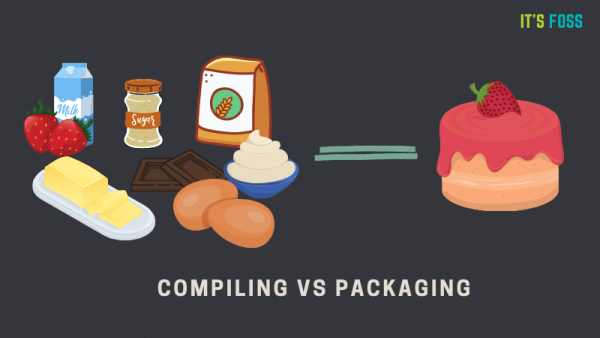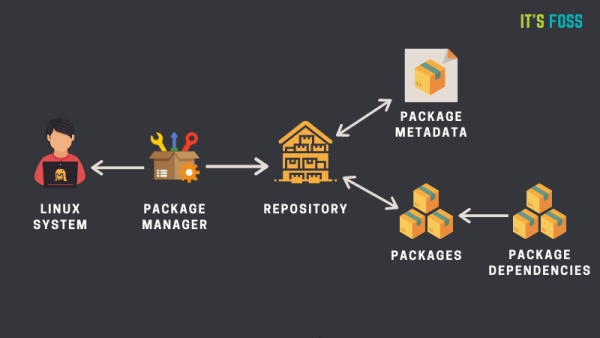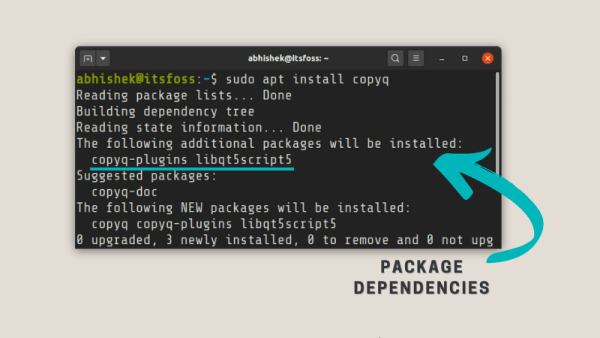Detailed explanation of Linux package manager
An important factor that distinguishes a Linux distribution is its package management system. In this article, you will learn about packaging and package managers in Linux. We'll introduce you to the concepts of "packages" and "package managers" and how they work, as well as some common package managers.

What is a package manager?
Simply put, a "package manager" (or "package manager") is a tool that allows users to install, remove, upgrade, configure, and manage software packages on an operating system. A package manager can be a graphical application like Software Center or a command-line tool like apt-get or pacman.
You'll notice that I use the word "package" a lot in tutorials and articles. To understand package managers, you must understand what packages are.
What is a package?
A "package" (or "software package") usually refers to an application, which can be a GUI application, a command line tool, or a software library (required by other software programs). A package is essentially an archive file that contains a binary executable, configuration files, and sometimes dependency information.
In the old days, software used to be installed from its source code. You would refer to a file (usually named README) to see what software components it requires and where the binaries are. It usually includes a configuration script or Makefile. You must compile the software yourself or handle all dependencies yourself (some software requires other software to be installed).
To get rid of this complexity, Linux distributions have created their own packaging formats that provide end users with ready-to-use binaries (precompiled software) for installing the software, while also providing some metadata (version number, description) and dependencies.
It’s like baking a cake versus buying a cake.

Around the mid-1990s, Debian created the DEB packaging format (.deb), and Red Hat Linux created the RPM (abbreviation for Red Hat Package Manager) packaging system (.rpm). The way to compile source code still exists, but is now optional.
To interact with or use the packaging system, you need a package manager.
How does the package manager work?
Please remember that a package manager is a general concept, it is not unique to Linux. You will often find package managers for various software or programming languages. There is a PIP package manager just for Python packages. Even the Atom editor has its own package manager.
Since the focus of this article is Linux, I will start from the Linux perspective. However, much of the explanation here can also be applied to package managers in general.
I created this diagram (based on the SUSE Wiki) so that you can easily understand how the package manager works.

Almost all Linux distributions have a "software repository", which is basically a collection of software packages. Yes, there can be more than one software repository. Software libraries contain different kinds of software packages.
Software warehouses also have metadata files, which contain software package information, such as software package name, version number, software package description, and software warehouse name. This is what you see using the apt show command in Ubuntu/Debian.
The package manager on your system will first interact with the metadata. The package manager creates a local cache of metadata on your system. When you run your package manager's update option (such as apt update), it updates the local metadata cache by referencing the metadata in the repository.
When you run the package manager's installation command (such as apt install package_name), the package manager will reference this cache. If it finds the package information in the cache, it uses the Internet to connect to the appropriate repository and download the package before installing it on your system.
A package may have dependencies. Meaning, it may require additional packages to be installed. Package managers usually handle these dependencies and install them automatically along with the package you are installing.

*The package manager in Linux will handle dependencies*
Similarly, when you use the package manager to delete a package, it will either automatically delete it or notify you that the system has unused packages that can be cleaned up.
In addition to the obvious tasks of installing and removing, you can also use the package manager to configure packages and manage them according to your needs. For example, you can prevent a certain package version from being upgraded during regular system updates. There's probably a lot more your package manager can do.
Different types of package managers
Package managers vary depending on the packaging system, but the same packaging system may have multiple package managers.
For example, RPM has Yum and DNF package managers. For DEB, you have command line based package managers like apt-get, aptitude, etc.

Synaptic Package Manager
Package managers are not necessarily command line-based, there are also graphical package management tools, such as Synaptic. Your distribution's Software Center is also a package manager, even if it's running apt-get or DNF under the hood.
in conclusion
I don't want to go into further detail on this topic, although I could go on, but that would detract from the goal of this topic - which is to give you a basic understanding of package managers in Linux.
I'm ignoring the new universal packaging formats like Snap and Flatpak for now.
The above is the detailed content of Detailed explanation of Linux package manager. For more information, please follow other related articles on the PHP Chinese website!

Hot AI Tools

Undresser.AI Undress
AI-powered app for creating realistic nude photos

AI Clothes Remover
Online AI tool for removing clothes from photos.

Undress AI Tool
Undress images for free

Clothoff.io
AI clothes remover

AI Hentai Generator
Generate AI Hentai for free.

Hot Article

Hot Tools

Notepad++7.3.1
Easy-to-use and free code editor

SublimeText3 Chinese version
Chinese version, very easy to use

Zend Studio 13.0.1
Powerful PHP integrated development environment

Dreamweaver CS6
Visual web development tools

SublimeText3 Mac version
God-level code editing software (SublimeText3)

Hot Topics
 deepseek web version entrance deepseek official website entrance
Feb 19, 2025 pm 04:54 PM
deepseek web version entrance deepseek official website entrance
Feb 19, 2025 pm 04:54 PM
DeepSeek is a powerful intelligent search and analysis tool that provides two access methods: web version and official website. The web version is convenient and efficient, and can be used without installation; the official website provides comprehensive product information, download resources and support services. Whether individuals or corporate users, they can easily obtain and analyze massive data through DeepSeek to improve work efficiency, assist decision-making and promote innovation.
 How to install deepseek
Feb 19, 2025 pm 05:48 PM
How to install deepseek
Feb 19, 2025 pm 05:48 PM
There are many ways to install DeepSeek, including: compile from source (for experienced developers) using precompiled packages (for Windows users) using Docker containers (for most convenient, no need to worry about compatibility) No matter which method you choose, Please read the official documents carefully and prepare them fully to avoid unnecessary trouble.
 Ouyi okx installation package is directly included
Feb 21, 2025 pm 08:00 PM
Ouyi okx installation package is directly included
Feb 21, 2025 pm 08:00 PM
Ouyi OKX, the world's leading digital asset exchange, has now launched an official installation package to provide a safe and convenient trading experience. The OKX installation package of Ouyi does not need to be accessed through a browser. It can directly install independent applications on the device, creating a stable and efficient trading platform for users. The installation process is simple and easy to understand. Users only need to download the latest version of the installation package and follow the prompts to complete the installation step by step.
 BITGet official website installation (2025 beginner's guide)
Feb 21, 2025 pm 08:42 PM
BITGet official website installation (2025 beginner's guide)
Feb 21, 2025 pm 08:42 PM
BITGet is a cryptocurrency exchange that provides a variety of trading services including spot trading, contract trading and derivatives. Founded in 2018, the exchange is headquartered in Singapore and is committed to providing users with a safe and reliable trading platform. BITGet offers a variety of trading pairs, including BTC/USDT, ETH/USDT and XRP/USDT. Additionally, the exchange has a reputation for security and liquidity and offers a variety of features such as premium order types, leveraged trading and 24/7 customer support.
 Get the gate.io installation package for free
Feb 21, 2025 pm 08:21 PM
Get the gate.io installation package for free
Feb 21, 2025 pm 08:21 PM
Gate.io is a popular cryptocurrency exchange that users can use by downloading its installation package and installing it on their devices. The steps to obtain the installation package are as follows: Visit the official website of Gate.io, click "Download", select the corresponding operating system (Windows, Mac or Linux), and download the installation package to your computer. It is recommended to temporarily disable antivirus software or firewall during installation to ensure smooth installation. After completion, the user needs to create a Gate.io account to start using it.
 Ouyi Exchange Download Official Portal
Feb 21, 2025 pm 07:51 PM
Ouyi Exchange Download Official Portal
Feb 21, 2025 pm 07:51 PM
Ouyi, also known as OKX, is a world-leading cryptocurrency trading platform. The article provides a download portal for Ouyi's official installation package, which facilitates users to install Ouyi client on different devices. This installation package supports Windows, Mac, Android and iOS systems. Users can choose the corresponding version to download according to their device type. After the installation is completed, users can register or log in to the Ouyi account, start trading cryptocurrencies and enjoy other services provided by the platform.
 gate.io official website registration installation package link
Feb 21, 2025 pm 08:15 PM
gate.io official website registration installation package link
Feb 21, 2025 pm 08:15 PM
Gate.io is a highly acclaimed cryptocurrency trading platform known for its extensive token selection, low transaction fees and a user-friendly interface. With its advanced security features and excellent customer service, Gate.io provides traders with a reliable and convenient cryptocurrency trading environment. If you want to join Gate.io, please click the link provided to download the official registration installation package to start your cryptocurrency trading journey.
 Why does an error occur when installing an extension using PECL in a Docker environment? How to solve it?
Apr 01, 2025 pm 03:06 PM
Why does an error occur when installing an extension using PECL in a Docker environment? How to solve it?
Apr 01, 2025 pm 03:06 PM
Causes and solutions for errors when using PECL to install extensions in Docker environment When using Docker environment, we often encounter some headaches...






